Buying your first home often comes with the responsibility of caring for your new lawn for the first time. Many first-time homeowners often feel overwhelmed by the duties of mowing, fertilizing, and maintaining a healthy, lush lawn. Lay the groundwork with these fundamental for lawn mowing as you cultivate your new green space.
How frequent to mow?
Unlike ornamental shrubs and trees on your property, grass requires regular cutting to prosper. Allowing your lawn grass to grow too tall results in weakened stems, disease susceptibility, and visual decline. As a general rule of thumb, you should plan to mow your lawn on a weekly basis during peak growing seasons in spring and summer. For cool-season grasses, maintain your turf at 2-4” in height through regular mowing. Schedule more frequent mowing for warm-season varieties like Bermuda, zoysia, and St. Augustine at 0.5-2” for optimal health and leaf density.
Never cut more than 1/3 the blade length at once
Shocking your grass plants with a dramatic, severely short haircut weakens your lawn over time. Lawns maintained too short often cannot photosynthesize enough or develop optimal root systems. For healthy grass and a great looking lawn, avoid removing more than 1/3 of the total leaf blade length per mowing session. So, if your grass is currently 4” tall, don’t mow it down below 3” in one pass. It’s better to do this in steps over successive mowings for a gradual transition to your desired lawn height. Small incremental cuts every mowing session prevent weakening your tur
Sharpen mower blades regularly
Robust grass health relies on sharp John Deere lawn tractors blades slicing leaves cleanly without tearing or shredding them. Dull blades impart damage and make an entry point for lawn diseases and pests. Take a moment once a month to check your blades for nicks, wear, or visible dullness. Use a file or electric grinder to sharpen blades and maintain peak cutting performance through the mowing season. Replace severely bent or cracked blades entirely for smooth mower operation.
Alternate mowing patterns
Repeatedly mowing your lawn on a single pathway each week can compact soil over time. This restricts root development and yields uneven growth. Make it a habit to switch up your walking pattern or direction of pushes every couple mowings. Mow north to south one week, then east to west on your next cut. Varying your passes prevents compressed zones for healthier soil conditions. Your lawn will showcase improved uniformity over the course of a growing season.
Be cautious of extra wet grass
Attempting to cut extremely soggy wet grass imparts a few problems for first-time lawn owners. Excess moisture dramatically increases disease transmission to healthy grass when wet clippings stick to leaves and stems. It increases safety risks due to reduced traction and easily bog-down mower engines. If the blades of grass produce a wet sheen or applied foot pressure leaves an impression, it’s best to curtail mowing and wait a few hours for improved drying. Exercise patience until grass firms up adequately before mowing for ideal results.
By adopting these fundamental best practices as a beginning lawn owner, you set yourself up for an attractive, lush lawn. Paying attention to proper mowing heights, blade care, and moisture levels makes all the difference in growing a healthy, uniform green carpet welcoming enjoyment all year long.


